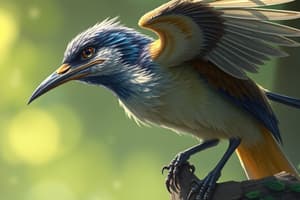Podcast
Questions and Answers
What is the primary purpose of feathers on birds?
What is the primary purpose of feathers on birds?
- To assist in swimming and diving
- To enhance the color patterns for mating
- To help with flying by increasing body weight
- To provide insulation and maintain body temperature (correct)
Which characteristic differentiates reptiles from amphibians?
Which characteristic differentiates reptiles from amphibians?
- Reptiles lay eggs with tough, paperlike shells (correct)
- Reptiles require water for breeding
- Reptiles have primarily aquatic habitats
- Reptiles have moist skin for respiration
What adaptation in fish helps them to navigate and sense their environment?
What adaptation in fish helps them to navigate and sense their environment?
- Scales for protection
- Fins for swimming
- Lateral line system for sensation (correct)
- Gills for respiration
What distinctive feature do monocot plants possess regarding their leaves?
What distinctive feature do monocot plants possess regarding their leaves?
Which of the following is NOT a characteristic of birds?
Which of the following is NOT a characteristic of birds?
What adaptation allows reptiles to survive in various habitats without relying on water for breeding?
What adaptation allows reptiles to survive in various habitats without relying on water for breeding?
What is a characteristic of fish that helps them reduce resistance when moving through water?
What is a characteristic of fish that helps them reduce resistance when moving through water?
Which of the following statements accurately describes the skinned adaptations of birds?
Which of the following statements accurately describes the skinned adaptations of birds?
Which feature is unique to monocots regarding their leaf structure?
Which feature is unique to monocots regarding their leaf structure?
What is a common feature shared by reptiles that allows them to live in dry environments?
What is a common feature shared by reptiles that allows them to live in dry environments?
What is the primary function of the lateral line system in fish?
What is the primary function of the lateral line system in fish?
What type of beak adaptation in birds is largely dependent on their dietary preferences?
What type of beak adaptation in birds is largely dependent on their dietary preferences?
What role do tails play in the flying abilities of birds?
What role do tails play in the flying abilities of birds?
Which of the following is an adaptation found in amphibians?
Which of the following is an adaptation found in amphibians?
What distinguishes mammals from other vertebrates?
What distinguishes mammals from other vertebrates?
Study Notes
Birds
- Covered with feathers that provide insulation and reduce density for flight.
- Feathers are coated in waterproof oil to prevent water absorption.
- Beaks are adapted to specific diets, reflecting the type of food they consume.
- Forelimbs modified into wings enable flight.
- Tails assist in controlling direction during airborne movement.
- Ear drums are located deep within the skull for protection.
- Females lay eggs with hard shells, adding protection to developing embryos.
- Examples include eagles, owls, and hawks.
Reptiles
- Reptiles are terrestrial vertebrates with adaptations for land living.
- Possess dry, scaly skin composed of an outer layer of epidermis with scales, minimizing water loss.
- Most species lay eggs with tough, paper-like shells, allowing reproduction in varying habitats without reliance on water.
- Cold-blooded, capable of regulating body temperature through behavioral adaptations.
- Example reptiles include lizards, snakes, turtles, tortoises, and crocodiles.
Vertebrates
- Vertebrates possess a backbone, classifying them as land-living organisms.
- Main classes include Fish, Amphibians, Reptiles, Birds, and Mammals.
Fish Adaptations
- Streamlined body shape reduces resistance while swimming.
- Covered in scales for physical protection against environmental hazards.
- Have a lateral line system for detecting movement and changes in water pressure.
- Gills enable underwater respiration by extracting oxygen from water.
Plant Characteristics (Monocots)
- Feature narrow, strap-shaped leaves with parallel veins.
- Seeds contain a single cotyledon, characteristic of monocotyledons.
- Roots are fibrous, providing stability and nutrient absorption.
- Stomata are uniformly distributed on both upper and lower leaf surfaces, aiding in gas exchange.
- Floral structures have petals that are in multiples of three, a distinctive trait of monocots.
Birds
- Covered with feathers that provide insulation and reduce density for flight.
- Feathers are coated in waterproof oil to prevent water absorption.
- Beaks are adapted to specific diets, reflecting the type of food they consume.
- Forelimbs modified into wings enable flight.
- Tails assist in controlling direction during airborne movement.
- Ear drums are located deep within the skull for protection.
- Females lay eggs with hard shells, adding protection to developing embryos.
- Examples include eagles, owls, and hawks.
Reptiles
- Reptiles are terrestrial vertebrates with adaptations for land living.
- Possess dry, scaly skin composed of an outer layer of epidermis with scales, minimizing water loss.
- Most species lay eggs with tough, paper-like shells, allowing reproduction in varying habitats without reliance on water.
- Cold-blooded, capable of regulating body temperature through behavioral adaptations.
- Example reptiles include lizards, snakes, turtles, tortoises, and crocodiles.
Vertebrates
- Vertebrates possess a backbone, classifying them as land-living organisms.
- Main classes include Fish, Amphibians, Reptiles, Birds, and Mammals.
Fish Adaptations
- Streamlined body shape reduces resistance while swimming.
- Covered in scales for physical protection against environmental hazards.
- Have a lateral line system for detecting movement and changes in water pressure.
- Gills enable underwater respiration by extracting oxygen from water.
Plant Characteristics (Monocots)
- Feature narrow, strap-shaped leaves with parallel veins.
- Seeds contain a single cotyledon, characteristic of monocotyledons.
- Roots are fibrous, providing stability and nutrient absorption.
- Stomata are uniformly distributed on both upper and lower leaf surfaces, aiding in gas exchange.
- Floral structures have petals that are in multiples of three, a distinctive trait of monocots.
Studying That Suits You
Use AI to generate personalized quizzes and flashcards to suit your learning preferences.




